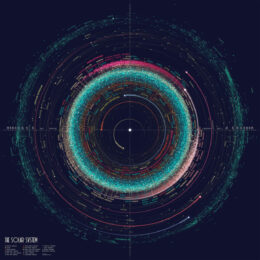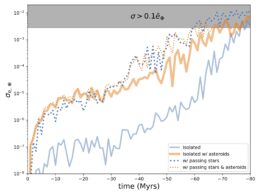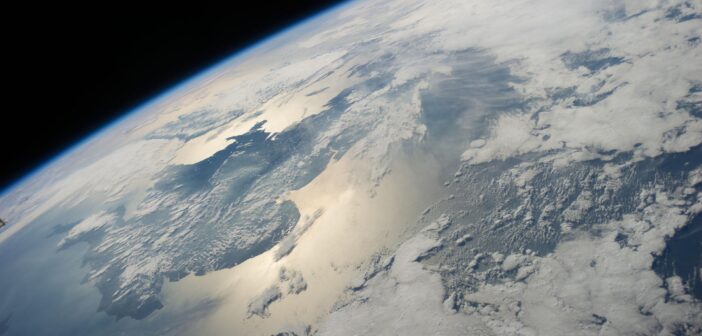The chaotic interactions between solar system bodies prevent us from knowing Earth’s precise orbit billions of years in the past or future. New research shows that passing stars introduce even more uncertainty, shortening the time out to which we can reliably predict Earth’s past orbit by 10%.
Uncertain Future, Uncertain Past

A map showing the positions of the planets and 18,000 asteroids on New Year’s Eve in 1999. Click for the high-resolution version of this image. [Eleanor Lutz; CC BY-NC-ND 4.0]
This chaotic element doesn’t just introduce uncertainty into the future behavior of the planets. It also means we can’t look infinitely far into their past motions, either. For Earth, the limit seems to lie around 60–70 million years ago, meaning that we cannot extrapolate Earth’s orbital history beyond that point. Because changes in Earth’s orbit influence our planet’s climate, researchers interpreting the ancient climate record contained in ice cores and sediment consider the behavior of Earth’s past orbit, and it’s critical for them to know how far back our orbital simulations are reliable.
Previous studies have focused on how planets and asteroids affect simulations of Earth’s past orbit. But the solar system doesn’t exist in a vacuum (metaphorically speaking) — could passing stars affect our ability to study Earth’s orbital history as well?
Chaos Caused by Passing Stars
In a research article published today, Nathan Kaib (Planetary Science Institute and University of Oklahoma) and Sean Raymond (National Centre for Scientific Research, France; University of Bordeaux) used numerical simulations to understand how passing stars impact our ability to trace back Earth’s orbit. Kaib and Raymond added a tiny amount of scatter in the positions of the planets and large asteroids and allowed the system to evolve backwards over 150 million years of simulation time.

The standard deviation of Earth’s orbital eccentricity as a function of time in the past. [Kaib & Raymond 2024]
Close Encounters of the Stellar Kind

The change in Earth’s orbital eccentricity, showing the effects of an HD 7977-like encounter at a time of 10 million years. Click to enlarge. [Adapted from Kaib & Raymond 2024]
To look more closely at a specific event, Kaib and Raymond considered the star HD 7977. HD 7977 currently sits about 250 light-years away, but its trajectory suggests that it passed within about 13,200 astronomical units (au) of our solar system 2.8 million years ago, making it possibly the closest recent stellar encounter. The team showed that the star’s passage likely didn’t impact Earth’s orbit much, unless the star came as close as the data allow — there’s a 5% chance that the star came within 3,900 au.
If HD 7977 did approach the solar system so closely, the encounter may have introduced a large amount of uncertainty into simulations of Earth’s past orbit. This allows for a broader range of past orbital eccentricities, opening up new possibilities to consider for Earth’s orbital and climatic past.
Citation
“Passing Stars as an Important Driver of Paleoclimate and the Solar System’s Orbital Evolution,” Nathan A. Kaib and Sean N. Raymond 2024 ApJL 962 L28. doi:10.3847/2041-8213/ad24fb

